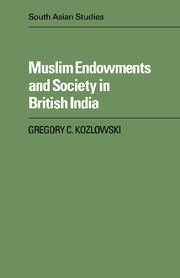Book contents
- Frontmatter
- Contents
- Acknowledgments
- Note on transliteration
- Abbreviations
- Introduction
- 1 Endowments in Muslim history, an overview
- 2 Muslim endowments and the temporal order in British India
- 3 Endowments and the faith
- 4 The unsettling of endowments
- 5 Creating a law of Muslim endowments
- 6 Muslim endowments and the politics of religious law
- Conclusion
- Bibliography
- Index
- CAMBRIDGE SOUTH ASIAN STUDIES
3 - Endowments and the faith
Published online by Cambridge University Press: 25 October 2011
- Frontmatter
- Contents
- Acknowledgments
- Note on transliteration
- Abbreviations
- Introduction
- 1 Endowments in Muslim history, an overview
- 2 Muslim endowments and the temporal order in British India
- 3 Endowments and the faith
- 4 The unsettling of endowments
- 5 Creating a law of Muslim endowments
- 6 Muslim endowments and the politics of religious law
- Conclusion
- Bibliography
- Index
- CAMBRIDGE SOUTH ASIAN STUDIES
Summary
Most contemporary studies of Islam define a waqf as a “charitable trust” or “pious foundation”. The previous two chapters expanded on that notion by concentrating on the familial and temporal dimensions present in many endowments. The institution did not lend itself to facile distinctions between “private” and “pious” interests. An individual who was childless and without close relatives might have created a waqf which sustained only religious and charitable activities. However, most endowments were not devoted purely to one purpose or the other. They were mixed. As noted later (chapters 5 and 6), the tendency to distinguish sharply between the apparently selfish and the seemingly altruistic was in large measure the result of the examination and criticism of the institution in colonial legal and political contexts. Deeds of endowment themselves simply mentioned the sums of money given to family members and dependants alongside of those which supported more public activities. This can be seen in the waqf created by the wakif Qaim Ali who lived in the town of Serai Kheta in Janpur district. The total income from the properties placed in the endowment was Rs. 9,000 per year. After paying the government's revenue and meeting the costs of managing the property, the remaining income was supposed to be spent in the following ways:
Rs. 2,400 To the six children of the founders and their descendants. Also, the custodian received his salary from this amount. The custodian had the power to add or exclude beneficiaries.
Rs. 600 For a hospital in Serai Kheta.
Rs. 20 To bring water from the zamzam well at Mecca.
Rs. 36 For recitation of the Quran for the benefit of the souls of the founders.
[…]
- Type
- Chapter
- Information
- Muslim Endowments and Society in British India , pp. 60 - 78Publisher: Cambridge University PressPrint publication year: 1985



